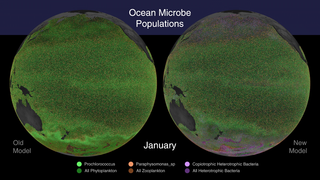Earth
ID: 4976
Research ships traveling from Hawaii into the north Pacific Ocean have measured quantities of tiny organisms in the water called Prochlorococcus using an instrument called SeaFlow. These organisms are phytoplankton that, like plants, turn carbon dioxide into oxygen. Prochlorococcus is both the smallest and most abundant photosynthesizing organism on the planet. Scientists observed a falloff in the quantity of these organisms as the ships moved northward; however, the falloff did not happen where the water cooled as the scientists expected. This was a bit of a mystery. The scientists hypothesized that the drop off was actually due to competition with other tiny organisms like heterotrophic bacteria and their shared predator, a type of zooplankton. They coded this relationship into a computational model of the oceans called Darwin. Sure enough, when the predator-prey relationship was included in the model, the drop off occurred in the same place as the ship measurements. This demonstrates a powerful combination of using computational models with the scientific method.
Seaflow Search for Prochlorococcus
Related
Visualization Credits
Andrew J Christensen (SSAI): Lead Visualizer
Stephanie Dutkiewicz (Massachusetts Institute of Technology): Scientist
Christopher Follett (Massachusetts Institute of Technology): Scientist
Francois Ribalet (University of Washington): Scientist
Laurence Schuler (ADNET Systems, Inc.): Technical Support
Ian Jones (ADNET Systems, Inc.): Technical Support
Stephanie Dutkiewicz (Massachusetts Institute of Technology): Scientist
Christopher Follett (Massachusetts Institute of Technology): Scientist
Francois Ribalet (University of Washington): Scientist
Laurence Schuler (ADNET Systems, Inc.): Technical Support
Ian Jones (ADNET Systems, Inc.): Technical Support
Please give credit for this item to:
NASA's Scientific Visualization Studio
NASA's Scientific Visualization Studio
Science Paper:
Trophic interactions with heterotrophic bacteria limit the range of Prochlorococcus
Short URL to share this page:
https://svs.gsfc.nasa.gov/4976
Data Used:
Note: While we identify the data sets used in these visualizations, we do not store any further details nor the data sets themselves on our site.
Keywords:
GCMD >> Earth Science >> Biosphere >> Plant Taxonomy >> Phytoplankton
SVS >> Model Data
SVS >> Hyperwall
NASA Science >> Earth
SVS >> Prochlorococcus
GCMD keywords can be found on the Internet with the following citation: Olsen, L.M., G. Major, K. Shein, J. Scialdone, S. Ritz, T. Stevens, M. Morahan, A. Aleman, R. Vogel, S. Leicester, H. Weir, M. Meaux, S. Grebas, C.Solomon, M. Holland, T. Northcutt, R. A. Restrepo, R. Bilodeau, 2013. NASA/Global Change Master Directory (GCMD) Earth Science Keywords. Version 8.0.0.0.0
Trophic interactions with heterotrophic bacteria limit the range of Prochlorococcus
Short URL to share this page:
https://svs.gsfc.nasa.gov/4976
Data Used:
ship/SeaFlow/doi10.5281/zenodo.3994953 also referred to as: SeaFlow datasets v1.3
Observed Data - University of Washington
SeaFlow is an underway flow cytometer that provides continuous shipboard observations of the abundance and optical properties of small phytoplankton (<5 μm in equivalent spherical diameter, ESD).
Credit:
Annette Hynes, Chris Berthiaume, Francois Ribalet, E Virginia Armbrust
Annette Hynes, Chris Berthiaume, Francois Ribalet, E Virginia Armbrust
Darwin
Model - Massachusetts Institute of Technology
The Darwin Project is an initiative to advance the development and application of novel models of marine microbes and microbial communities, identifying the relationships of individuals and communities to their environment, connecting cellular-scale processes to global microbial community structure.
Credit:
Massachusetts Institute of Technology, Gordon and Betty Moore Foundation, Simons Foundation, NSF, NASA
Massachusetts Institute of Technology, Gordon and Betty Moore Foundation, Simons Foundation, NSF, NASA
Keywords:
GCMD >> Earth Science >> Biosphere >> Plant Taxonomy >> Phytoplankton
SVS >> Model Data
SVS >> Hyperwall
NASA Science >> Earth
SVS >> Prochlorococcus
GCMD keywords can be found on the Internet with the following citation: Olsen, L.M., G. Major, K. Shein, J. Scialdone, S. Ritz, T. Stevens, M. Morahan, A. Aleman, R. Vogel, S. Leicester, H. Weir, M. Meaux, S. Grebas, C.Solomon, M. Holland, T. Northcutt, R. A. Restrepo, R. Bilodeau, 2013. NASA/Global Change Master Directory (GCMD) Earth Science Keywords. Version 8.0.0.0.0












